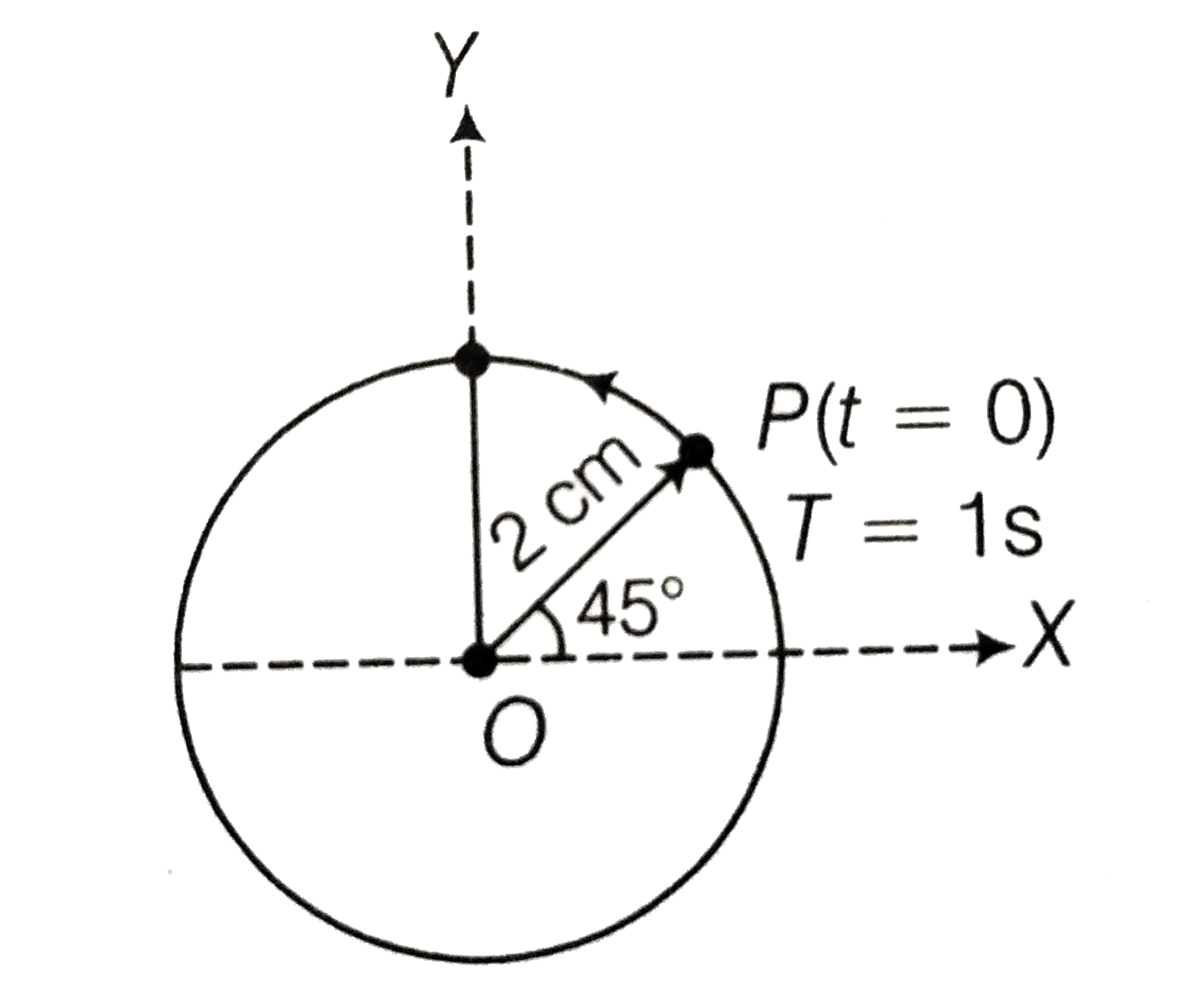Plot the corresponding reference circle for each of the following simple hoarmonic motions. Indicate the intial(t=0) position of the particle, the radius of the circle, and the angular speed of the rotating particle. For simplicity, the sense of rotation may be fixed to be anticlockwise in every case :(x is in cm and t is in s ).
(a) x=−2sin(3t+π/3) (b)x=cos(π/6−t) (c) x=3sin(2πt+π/4) (d) x=2cosπt
If we express each function in the form x=acos(ωt+ϕ) …(i)
where ϕ is the initial phase, i.e., ϕ represents the angle which the intial radius vector of the particle makes with the positive direction of x-axis.
(a) x=−2sin(3t+π/3)=2cos(π2+3t+π3)orx=2cos(3t+5π6)
Comparing it with equation (i), we note that a=2,ω=3andϕ=5π/6
Hence, the reference circle will be as shwon in figure.
(b) x=cos(π6−t)=cos(t−π/6) [∵cos(−θ)=cosθ]
Comparing it with equation (i), we not that a=1,ω=1andϕ=−π/6.
The reference circle will be as shown in figure.
(c)x=3sin(2πt+π/4)=3cos(2πt+3π2+π4)
Comparing it with equation (i), we note that a=3,ω=2π and ϕ=3π2+π4=7π4
The reference circle will be as shown in figure.
(d) x=2cosπt.
Comparing it with equation (i), we note that a=2,ω=π and ϕ=0.
The reference circle will be

Topper's Solved these Questions
- OSCILLATIONS AND WAVESBook:PRADEEPChapter:OSCILLATIONS AND WAVESExercise:Additional Exercises
Explore 6 Videos
- OSCILLATIONS AND WAVESBook:PRADEEPChapter:OSCILLATIONS AND WAVESExercise:NCERT CHAPTER
Explore 26 Videos
- OSCILLATIONS AND WAVESBook:PRADEEPChapter:OSCILLATIONS AND WAVESExercise:Advanced Problems For Competitions
Explore 20 Videos
- MATHEMATICAL TOOLSBook:PRADEEPChapter:MATHEMATICAL TOOLSExercise:Fill in the blanks
Explore 5 Videos
- PHYSICAL WORLD AND MEASUREMENTBook:PRADEEPChapter:PHYSICAL WORLD AND MEASUREMENTExercise:Competiton Focus Jee Medical Entrance
Explore 18 Videos
Similar Questions
Plot the corresponding reference circle for given SHM, indicate the initial (t=0) position of the paritcle, the radius of the circle , and the angular speed of the rotating paritcle. Consider anticlockwise direction for rotation. x=−3sin(2t+π4) (Express in the form , x= Acos ( omega t + phi)).
View SolutionPlot the corresponding reference circle for given SHM x=2cos(π3−t) .Indicate the initial (t−0) position of the particle , the radius of the circle and the angular speed of the rotating particle . Consider anticlockwise direction for rotation.
Hint : x=2cos(π3−t)=2cos(t−π3) as cos(−θ)=cosθ . Compare with x=Acos(ωt+ϕ)
View Solution
Knowledge Check
A partilce is executive simple harmonic motion given by
x=5sin(4t−π6)
The velocity of the particle when its displacement is 3 units isA2π3 unitsB5π6 unitsC20 unitsD16 unitsThe displacement of a particle executing simple harmonic motion is given by
x=3sin(2πt+π4)
where x is in metres and t is in seconds. The amplitude and maximum speed of the particle isA3m, 2πms−1B3m, 4πms−1C3m, 6πms−1D3m, 8πms−1The displacement of a particle in S.H.M. is given by x=Bsin(ωt+α). The initial position (at time t=0), of the particle is the initial phase angle if the angular frequency of the particle is πrad/s ?
Aπ2Bπ4Cπ6Dπ5
A particle is subjected to two simple harmonic motions.
x1=4.0sin(100πt) and x2=3.0sin(100πt+π3)
Find
(a) the displacement at t=0
(b) the maximum speed of the particle and
(c ) the maximum acceleration of the particle.
View SolutionFigure shows the circular motion of a particle. The radius of the circle, the period, sense of revolution and the initial position are indicated in the · figure. The simple harmonic motion of the X-projection of the radius vector of the rotating particle Pis

View SolutionThe equation of particle executing simple harmonic motion is x=(5m)sin[(πs−1)t+π3]. Write down the amplitude, time period and maximum speed. Also find the velocity at t=1s.
View SolutionPosition-time relationship of a particle executing simple harmonic motion is given by equation
x=2sin(50πt+2π3) where x is in meters and time t is in seconds.
What is the position of particle at t=0.5s ?
View SolutionPosition-time relationship of a particle executing simple harmonic motion is given by equation
x=2sin(50πt+2π3) where x is in meters and time t is in seconds.
What is the position of particle at t=1s ?
View Solution